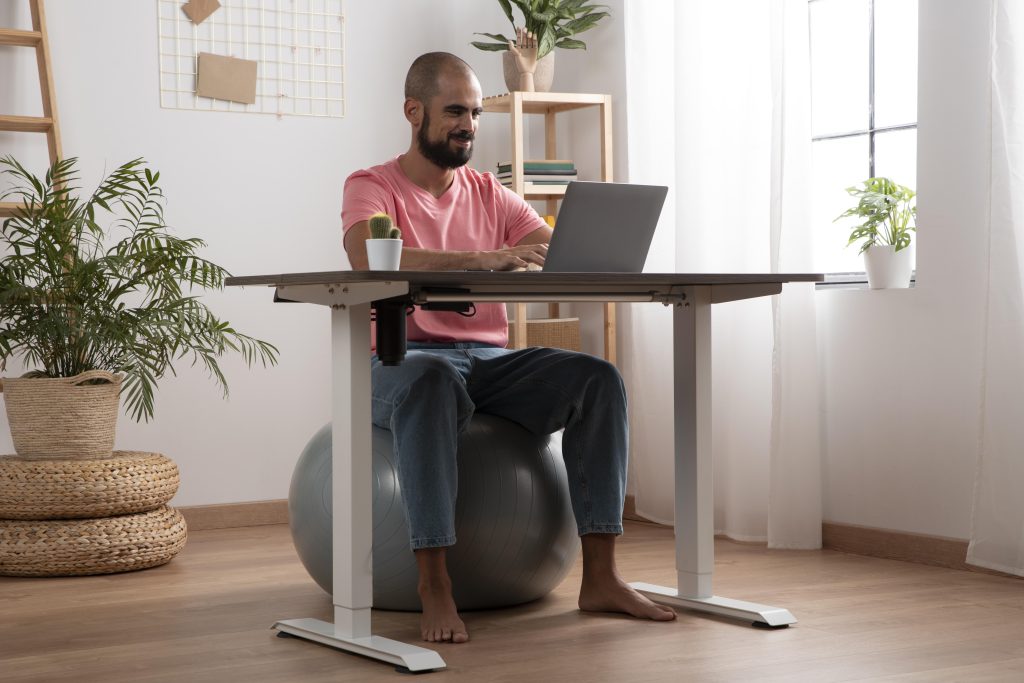Ergo-Hacks: Small Changes, Big Impact on Workstation Ergonomics

As long as you’re in the workforce, you spend a significant portion of your life at the workplace. Whether you’re working from a traditional office or a home office setup, how you interact with your workspace can profoundly impact your overall well-being.
While it might seem like a daunting task to overhaul your entire workspace, there are plenty of small changes, or “Ergo-Hacks” that can make a big difference in your daily comfort and productivity. In this blog post, we’ll explore some simple yet highly effective adjustments you can make to transform your workspace into a haven of ergonomic bliss.
Elevate Your Monitor
One of the most common ergonomic pitfalls is having your computer monitor too low. This forces you to hunch over, straining your neck and shoulders.[1] To combat this, invest in a monitor stand or simply prop your monitor up on a few books or a sturdy box. Your monitor should be at eye level, with the top of the screen at or just below eye level. This small change will alleviate neck strain and improve your posture instantly.
Support Your Lumbar Region
Sitting for extended periods can wreak havoc on your lower back. Invest in a lumbar support cushion or use a rolled-up towel to maintain the natural curve of your lower spine. This added support will reduce the risk of back pain and fatigue, ensuring you can work comfortably for longer hours.[2]
Set Up a Standing Desk Station
Sitting all day isn’t great for your health, and it can lead to various musculoskeletal issues. Consider creating a standing desk station by using a standing desk converter or by improvising with items like sturdy boxes or stackable books.[3] By alternating between sitting and standing, you can reduce the strain on your back, increase blood circulation, and boost your energy levels throughout the day.
Opt for an Ergonomic Chair
Investing in a high-quality ergonomic chair is a game-changer for your workspace. Look for a chair with adjustable height, lumbar support, and armrests. Your feet should rest flat on the floor or on a footrest, and your thighs should be parallel to the ground when sitting. A well-designed chair will provide comfort and support, reducing the risk of back pain and discomfort.
Keyboard and Mouse Placement
The placement of your keyboard and mouse can significantly impact your comfort and productivity. Position them at a height that allows your wrists to remain in a neutral, straight position.[4] A keyboard tray or an ergonomic keyboard with a built-in palm rest can help achieve this. Additionally, use a mouse pad with wrist support to minimize strain during prolonged mouse usage.
Organize and Declutter
A cluttered workspace can contribute to stress and decreased productivity. Take the time to declutter your desk, keeping only essential items within arm’s reach. Use cable management solutions to prevent wires from tangling, and organize your supplies to reduce the need for excessive reaching or bending.[5]
Office Ergonomics Self-Assessment and Adjustment Tool
This app gathers general information. It helps in; reviewing employees’ workspace to identify risks with workspace set-up, providing immediate feedback on adjustments to improve employee biomechanics and comfort, and also Identifying tools, equipment, and space modifications necessary for further improvement.
Implement the 20-20-20 Rule
To reduce eye strain and prevent computer vision syndrome, practice the 20-20-20 rule. Every 20 minutes, take a 20-second break and focus on something at least 20 feet away. This simple habit can help relax your eye muscles and maintain your visual comfort.
Stay Active
Lastly, remember to move! Even with the most ergonomic setup, prolonged periods of sitting or standing can lead to discomfort. Incorporate short breaks for stretching or walking to keep your muscles engaged and prevent stiffness. You can use the OOHMS Break app to ensure adherence to routines by reminding you to get up and stretch with pop-up notifications. It also comes with a variety of stretches that target different parts of your body providing benefits such as improvement of posture and blood flow to muscles, prevention and remedy of back pain, and great stress relief
Workplace ergonomics doesn’t require a complete office overhaul. By implementing these small but impactful Ergo-Hacks, you can transform your workspace into a comfortable and productive environment. Remember that your well-being is paramount, and investing in your ergonomic health is an investment in your overall quality of life. So, take these simple steps today and feel the big impact they can have on your workplace ergonomics. Your body will thank you for it.

This is very helpful. Thank you OOHMS